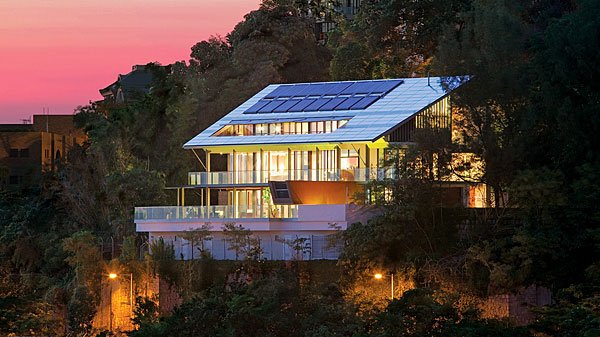
This villa on Mount Davis is an inspirational take on green architecture
The dawn of the Digital Age saw humankind embrace all things electronic. Engineers have developed smart phones, smart cars, smart watches and wearable tech. But far more elusive and ambitious is the greater project of the smart house.
We first encountered “Mount Davis Villa” when visiting the International Design Furniture Fair that ran last August at the Hong Kong Convention and Exhibition Centre. It was part of a touring exposition entitled Reading Single Family House, a showcase of inventive homes in Greater China curated by Index Architecture founder Anderson Lee.
The project caught our attention as a rare subject belonging to a dying breed of single-family homes in Hong Kong. Upon closer inspection, the mystery project on Pok Fu Lam’s mountainside revealed more and more ingenious features that would delight the cultivated mind: from solar design principles and wind generators to hydro-seed technology for wall landscaping.

Clearly no funds were spared in the fulfilment of the home-owner’s vision. The man is described as a “naturalist and avid bird watcher involved with the World Wildlife Fund.” Further digging led us to Markus Jebsen, executive chairman of MF Jebsen Group and a direct descendant of Jacob Jebsen – founder of its colonial-era parent company. The Danish businessman belongs to a 120-year-old trading family whose assets include one of the world’s largest Porsche dealerships and Blue Girl, the city’s best-selling brew.
“The owner insisted on environmental friendliness and as much self-sufficiency as possible,” said architect and interior designer Santa Raymond, who reviewed the project. “Materials and construction methods aimed to be [as] sustainable as possible, with – for instance – rubble from demolition being used to level the site. Wind turbines were considered but, apart from planning issues, the lack of access to a local grid into which to feed excess power removed this as a practical option.”
The three-storey house sits on the southern slope of Mount Davis with broad views over the Lamma Channel. Formerly occupying this 600-square-metre site was a one-storey European house with a swimming pool belonging to a relative. It was demolished to make way for the current building, which is sandwiched between Mount Davis Road from the top and Victoria Road below.

Award-winning architecture and urban design firm Farrells was chosen to turn this vision of an eco-friendly family home into reality. Designers were initially set back by the long and narrow site; regulations limited interior space to just 420-square-metres across three floors. In response to the rectangular constraints, Farrells designed a long building – a concept partially inspired by the Malaysian longhouse. The form ultimately allowed wide sea views from most rooms, promoted cross ventilation and provided an acoustic shield.
To the north, a large vertical stone façade anchors the house to the ground and shelters the dwelling from the road. Clad in split face stone, the wall is reminiscent of Mount Davis itself. The stainless steel roof, inclined at 30 degrees, also echoes the slope of the hill.
On the ground floor, inhabitants congregate in the double-height family room, which has direct access to the external garden terrace and children’s swimming pool. Guest bedrooms are located here as well, while the family’s bedrooms are on the second floor.
The first level is comprised of the kitchen, main living room and dining space. A large opening in the stone feature wall makes up the main entrance, accessed from the outside by a cantilevered staircase. A spiritual rejuvenation area – designed to ‘let the dragon through’ – includes both a gymnasium and a projecting infinity lap-pool.

For all its aesthetic appeal, the villa was fundamentally designed to utilise the latest environmentally friendly technologies. Double glazed windows, large mass walls, and an insulated roof reduce the house’s cooling load. North-facing operable skylights also facilitate a stack effect for natural cooling in summer months.
The roof’s aforementioned solar collectors provide hot water that powers the water-fired absorption chiller, which provides air-conditioning. In addition, a gray water system was incorporated to collect rainwater from the large roof and garden where it is stored in a tank and used for bathroom flushing and garden irrigation.
“Young architects can’t work on anything but boxes nowadays,” says Lee, who featured the 2005 villa in his exhibition. He chose the Jebsen home as one of the few Hong Kong residences that can be proudly presented as a triumph in holistic, ‘life-cycle approach’ design.
Raymond concurs: “The house is impressive at every level. It is a highly sophisticated solution on a demanding site that works as a family house, as a part of its location and as an example of innovative thinking. Its aesthetic defies categorisation, but communicates that it is an imaginative solution to a specific location and situation.”
American naturalist Edward Osborne Wilson once said, “Nature holds the key to our aesthetic, intellectual, cognitive and even spiritual satisfaction.” For all of mankind’s advances in building and composition, it looks as if we remain destined to return to the work of the greatest designer and architect of our smart planet: Mother Earth.
This article originally appears as “The Smart House” by Julienne C. Raboca on Gafencu Magazine’s March 2018 print edition. Photos are courtesy of Farrells and Carsten Schael.







